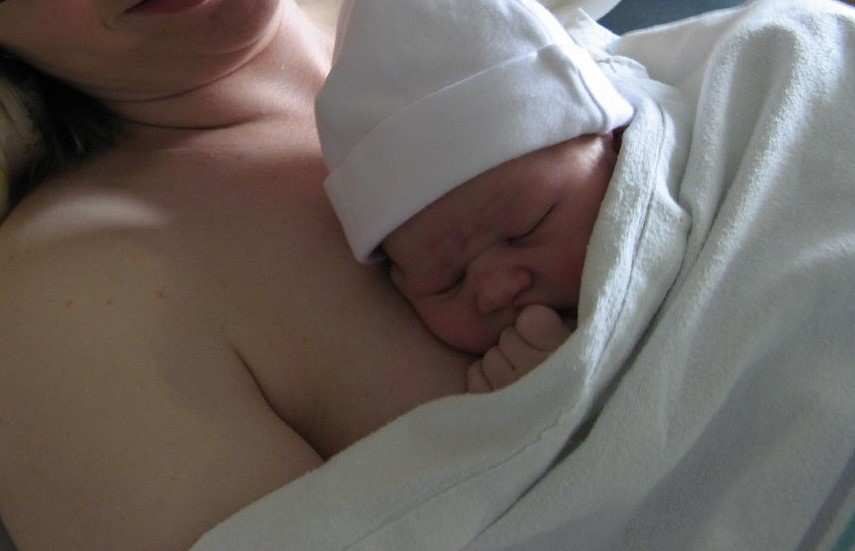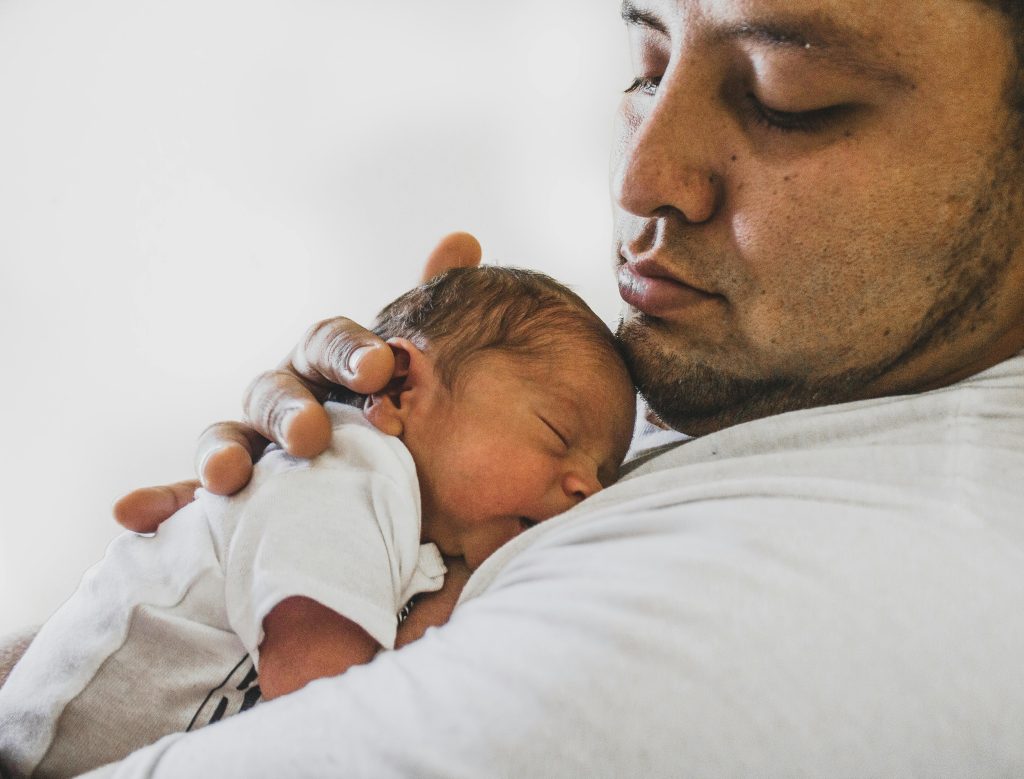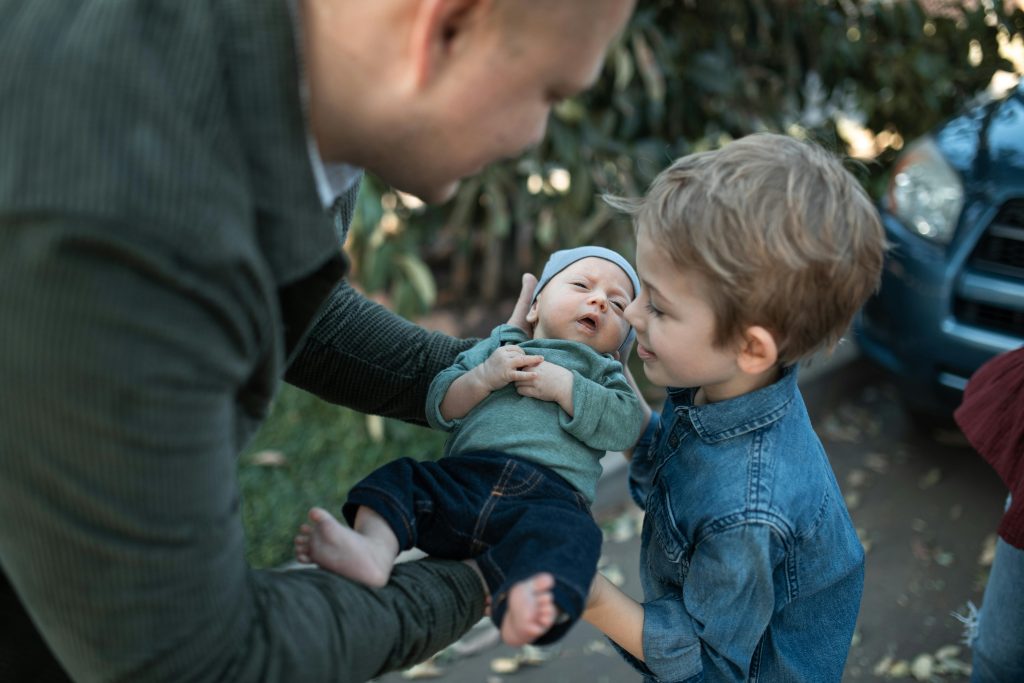11.3 Psychosocial Adaptation to Parenthood
The new family goes through many psychosocial changes and adaptations during the postpartum period, including creating secure attachments, relying on extended family support, and incorporating cultural traditions and beliefs.
Parent-Newborn Attachment
Supporting parent-newborn attachment is an important postpartum nursing responsibility. Infants are born with innate attachment behaviors such as crying, clinging, and following with their gaze. These behaviors are also known as proximity-seeking behaviors. The purpose of these behaviors is to engage caregivers to meet the infant’s needs for survival. Secure attachment occurs when a caregiver is sensitive to the infant’s needs and consistently and effectively responds to them. Infants who experience secure attachments feel protected and comforted by their caregivers when distressed, which, in turn, allows them to confidently explore their world as they develop into toddlers and children. Early parental sensitivity can also serve as a protective factor if families are exposed to multiple risk factors related to social determinants of health.[1],[2],[3]
Research indicates that children who experience secure attachments develop resilience (the capacity to cope with difficulties), stronger self-esteem, more independence, better academic performance, successful social relationships, and less depression and anxiety. Conversely, children who experience insecure attachments (also called disorganized attachments) may experience emotional and behavioral difficulties. Therefore, promoting the development of secure attachments during the postpartum period is crucial for a child’s healthy development.[4],[5]
Attachment Theories
The Maternal Role Attainment Theory by Ramona Mercer and psychological processes of “Taking-In,” “Taking-Hold,” and “Letting-Go” by Reva Rubin can help nurses understand how to assist parents and newborns develop successful attachment.[6]
The Maternal Role Attainment Theory by Ramona Mercer suggests that early skin-to-skin contact, breastfeeding, and minimizing time apart promotes bonding, decreases maternal anxiety, and encourages attainment of the maternal role.[7]
Reva Rubin described psychological phases called taking-in, taking-hold, and letting-go that occur as the postpartum client adapts to a new maternal role. During the taking-in phase that occurs in the first one to three days after birth, the postpartum client is focused on their physical recovery, adapting to body changes, and caring for the newborn. The client is reliant on the nurse, partner, or support person for physical help and is psychologically focused on their labor and birth experience. The nurse encourages the parents to talk about and process their feelings. The nurse provides assistance with caring for the newborn while also encouraging parental independence supported by positive reinforcement.[8]
During the taking-hold phase that occurs four to ten days after delivery, the postpartum client’s focus turns to the newborn. The client becomes more confident in caring for the newborn and more comfortable in the maternal role but may continue to seek support from family members and friends who can provide guidance and understanding.[9]
The letting-go phase begins several weeks after delivery as the client establishes a new parental role identity and focuses on the family unit. During this phase, the client accepts physical separation from the infant, lets go of their former role as a childless person, accepts the responsibilities of parenthood, and adjusts to the infant’s dependency and helplessness.[10]
Promoting Secure Attachment
Nurses encourage immediate emotional bonding after delivery with skin-to-skin contact. Skin-to-skin contact decreases the stress of the newborn, regulates their temperature, and increases breastfeeding success. See an image of skin-to-skin contact in Figure 11.7.[11],[12]

Partners and/or support persons who are involved during the prenatal, birth, and postpartum periods typically feel more attached to their newborn and report higher levels of self-esteem and self-worth. The nurse encourages their participation in the physical care of the newborn, so they feel their role is valued and they are positively contributing.[13] See Figure 11.8[14] for an image of a father holding a newborn.

Attachment Disorders
Risk factors for attachment disorders include clients who seem unhappy about the pregnancy, avoid talking to the baby, avoid making eye contact or skin-to-skin contact, or don’t exhibit soothing behaviors or cuddling. Parents with a history of depression, homelessness, substance use disorder, intimate partner violence, sexual abuse, or other barriers related to social determinants of health may exhibit fewer attachment behaviors.[15]
Parents of a newborn admitted to the newborn intensive care unit (NICU) are also at risk for developing attachment problems. The medical equipment attached to the baby can make parents feel overwhelmed and afraid to touch them. Parents are limited in the amount of care they can provide to their newborn, which can lead to feelings of fear, stress, and insecurity. Nurses can foster bonding and secure attachment by recognizing the need for parental involvement, acknowledging their feelings, and encouraging participation in newborn care.[16]
Family Adjustments
Extended families often provide emotional, physical, and social support to new parents after discharge from the hospital. Family members may bring nutritious food, help care for the newborn, and give the parents time to rest and adjust to their new parental roles.
If there are other siblings in the family, they must also adapt to a new family member. The success of adaptation is reliant upon the age of the sibling, their preparation and education regarding the new baby, and existing feelings of secure attachment to the parents. Nurses explain how siblings will be able to meet the newborn in the facility and suggest ways to help siblings adapt to the new baby, such as sharing “I’m the Big Brother” or “I’m the Big Sister” shirts. See Figure 11.9[17] for an image of a sibling adapting to their new family member.[18]

Cultural Considerations
Nurses support clients and their family members in a culturally sensitive manner, so an increased awareness of a variety of cultural practices can improve a nurse’s ability to advocate for a client’s cultural values and beliefs. Recovery during the postpartum period is often influenced by the client’s values, beliefs, and cultural traditions. A qualitative systematic review examined traditional postpartum cultural practices in over 20 different countries. Common themes across cultures included organized support for the mother, prescribed periods of rest and restriction of activities, specific foods to be eaten or avoided, postpartum hygiene practices, and infant care and breastfeeding.[19] Family member support is almost universally provided by the mother, mother-in-law, or other female relatives. Specific diets may be followed during the postpartum period, along with ingestion of herbs with specific medicinal properties.[20] Examples of several postpartum cultural traditions are described in the following box.
Examples of Postpartum Cultural Traditions
- Chinese Postpartum Confinement (Zuo Yuezi): In Chinese culture, new mothers practice a month-long confinement period known as “Zuo Yuezi.” During this time, the mother rests at home; avoids cold foods, drinks, and activities; and follows dietary restrictions to restore balance in the body. Special postpartum foods and herbs are consumed to aid recovery.[21]
- Mexican Practices: In Mexican culture, the “La Cuarentena” or 40-day postpartum period is observed. The mother avoids certain foods, activities, and contact with cold air or water. Special herbal baths and massages are used to aid healing, and the mother receives support from family members.[22]
- Amish and Mennonite Traditions: Postpartum mothers receive support from extended family and community members with practical assistance with household tasks and traditional home-cooked meals to aid recovery.
- Indigenous Practices: Indigenous postpartum care practices often involve traditional healing methods, rituals, and reliance on community support.
- Jewish Traditions: Niddah is a set of Jewish laws and practices that govern a woman’s sexual relationship with her husband during her menstrual cycle and while she is experiencing postpartum lochia. The woman is considered “impure” during these times and must not have sexual relations until she performs a cleansing ritual that includes immersion to be considered “pure” again.[23] There are also many restrictions if the woman delivers or remains in the hospital on Shabbos. Shabbos, also known as the Sabbath, is a weekly day of rest that takes place from sunset on Friday to sunset on Saturday.[24]
- Middle Eastern/Muslim Practices: A call to prayer called the Azan is whispered by the father into the baby’s right ear as its head and body are delivered so the first thing the baby hears is the name of Allah and the Kalimah. Many clients request the room to be silent during delivery until this ritual has been performed. There may also be restrictions related to the presence of the spouse and/or support person during delivery.[25]
- Jehovah’s Witness Practices: If postpartum hemorrhage occurs, blood product transfusion may be declined.[26]
- Hmong Traditions: Although their primary spoken language may be Hmong, many Hmong clients do not read the Hmong language because the written language is relatively new. Hmong postpartum practices may include the following[27]:
- Poj Niam (Postpartum Confinement): A period of confinement occurs after childbirth that can range from 30 to 100 days. During this time, the mother avoids exposure to cold air, cold water, and cold foods with the belief that the body needs warmth to recover properly.
- Postpartum Diet: The postpartum diet focuses on warm and nourishing foods that are believed to help the mother recover and produce ample breast milk. Common foods include chicken soup and rice cooked with herbs. Herbal remedies are commonly used to address various postpartum concerns, such as pain relief, healing, and overall well-being. Different herbs are chosen based on the mother’s specific needs.
- Hawv Kua (Binding of the Abdomen): Abdominal binding is performed to help support the uterus and abdominal muscles after childbirth. A cloth is used to tightly wrap the abdomen to aid in the healing process and prevent sagging of the belly.
- Hawv Tsev (Staying Indoors): During the postpartum period, Hmong women traditionally avoid going outside, especially if it’s cold or windy. They also avoid going to other people’s homes outside of the family. Staying indoors is believed to protect the mother from negative energies and ensure a smoother recovery.
- Hawv Lub Zos (Family Support): Family members play a crucial role in supporting the new mother during the postpartum period. They assist with household tasks, childcare, and cooking to allow the mother to rest and recover.
- Spiritual Practices: For many Hmong people, spirituality is integral to their daily lives. Traditional rituals and practices may be incorporated into the postpartum period to ensure the well-being of both the mother and the baby.
Read a qualitative systematic review about cultural postpartum practices and rituals: Traditional Postpartum Practices and Rituals: A Qualitative Systematic Review.
Providing postpartum care to LGBTQ+ (Lesbian, Gay, Bisexual, Transgender, Queer/Questioning, and others) clients also requires a sensitive approach that respects the individual’s preferences in a safe environment. Considerations for providing LGBTQ+ postpartum care are described in the following box.
LBGTQ+ Postpartum Care Considerations[28]
- Identity and Pronouns: Use the individual’s chosen name, gender identity, and pronouns. Avoid assumptions about their sexuality.
- Comprehensive Health History: Gather information about the individual’s medical history that includes gender-affirming treatments or surgeries that may impact postpartum care. Recognize that individuals may have unique preferences for medical interventions during the postpartum period, such as hormone therapy.
- Family Structures: A variety of family structures may apply to LGBTQ+ clients, such as same-sex couples, transgender parent(s), surrogacy, and adoptive parents. Involve supportive partners and other family members as appropriate during postpartum care.
- Chestfeeding: Chestfeeding is an inclusive term that refers to feeding an infant from the chest. It may include lactation for transgender men or transgender women (with prescribed medications) or attaching a tube to their nipple to feed the infant formula, their partner’s human milk, or donated human milk. Other people chestfeed simply to comfort or soothe their infant without milk, called non-nutritive sucking, similar to a pacifier.[29]
- Gender Neutral Terms: Clients may prefer terms like “parent” instead of “mother” and “father.”
- National Collaborating Centre for Mental Health (UK). (2015) Children's attachment: Attachment in children and young people who are adopted from care, in care or at high risk of going into gare. National Institute for Health and Care Excellence (NICE) Guideline, Number 26. https://www.ncbi.nlm.nih.gov/books/NBK356196/ ↵
- Gerlach, J., Fobel, J. M., Vierhaus, M., et al. (2022). Family risk and early attachment development: The differential role of parental sensitivity. Infant Mental Health Journal, 43(2), 340-356. https://onlinelibrary.wiley.com/doi/10.1002/imhj.21964 ↵
- National Collaborating Centre for Mental Health (UK). (2015). Children's attachment: Attachment in children and young people who are adopted from care, in care or at high risk of going into care. National Institute for Health and Care Excellence (NICE) Guideline, Number 26. https://www.ncbi.nlm.nih.gov/books/NBK356196/ ↵
- National Collaborating Centre for Mental Health (UK). (2015) Children's attachment: Attachment in children and young people who are adopted from care, in care or at high risk of going into care. National Institute for Health and Care Excellence (NICE) Guideline, Number 26. https://www.ncbi.nlm.nih.gov/books/NBK356196/ ↵
- Gerlach, J., Fobel, J. M., Vierhaus, M., et al. (2022). Family risk and early attachment development: The differential role of parental sensitivity. Infant Mental Health Journal, 43(2), 340-356. https://onlinelibrary.wiley.com/doi/10.1002/imhj.21964 ↵
- Wells-Beede, E. (2022). Nursing care of women, families, and newborns. Texas A&M University. https://pressbooks.pub/nurs323/ ↵
- Wells-Beede, E. (2022). Nursing care of women, families, and newborns. Texas A&M University. https://pressbooks.pub/nurs323/ ↵
- Wells-Beede, E. (2022). Nursing care of women, families, and newborns. Texas A&M University. https://pressbooks.pub/nurs323/ ↵
- Wells-Beede, E. (2022). Nursing care of women, families, and newborns. Texas A&M University. https://pressbooks.pub/nurs323/ ↵
- Wells-Beede, E. (2022). Nursing care of women, families, and newborns. Texas A&M University. https://pressbooks.pub/nurs323/ ↵
- Giles, A., Prusinski, R., & Wallace, L. (2024). Maternal-newborn nursing. OpenStax. https://openstax.org/books/maternal-newborn-nursing/pages/1-introduction ↵
- This image is derivative of “144554862_f49834f30b_b” by Anthony J and is licensed under CC BY 2.0 ↵
- Giles, A., Prusinski, R., & Wallace, L. (2024). Maternal-newborn nursing. OpenStax. https://openstax.org/books/maternal-newborn-nursing/pages/1-introduction ↵
- “pexels-laura-garcia-1667452-3617855” by Laura Garcia, Pexels.com is licensed under CC0 ↵
- Giles, A., Prusinski, R., & Wallace, L. (2024). Maternal-newborn nursing. OpenStax. https://openstax.org/books/maternal-newborn-nursing/pages/1-introduction ↵
- Giles, A., Prusinski, R., & Wallace, L. (2024). Maternal-newborn nursing. OpenStax. https://openstax.org/books/maternal-newborn-nursing/pages/1-introduction ↵
- “pexels-rdne-6849592” by RDNE Stock project, Pexels.com is licensed under CC0 ↵
- Giles, A., Prusinski, R., & Wallace, L. (2024). Maternal-newborn nursing. OpenStax. https://openstax.org/books/maternal-newborn-nursing/pages/1-introduction ↵
- Dennis, C. L., Fung, K., Grigoriadis, S., Robinson, G. E., Romans, S., & Ross, L. (2007). Traditional postpartum practices and rituals: A qualitative systematic review. Women’s Health, 3(4), 487-502. https://journals.sagepub.com/doi/10.2217/17455057.3.4.487 ↵
- Dennis, C. L., Fung, K., Grigoriadis, S., Robinson, G. E., Romans, S., & Ross, L. (2007). Traditional postpartum practices and rituals: A qualitative systematic review. Women’s Health, 3(4), 487-502. https://journals.sagepub.com/doi/10.2217/17455057.3.4.487 ↵
- Raven, J. H., Chen, Q., Tolhurst, R. J., & Garner, P. (2007). Traditional beliefs and practices in the postpartum period in Fujian Province, China: A qualitative study. BMC Pregnancy and Childbirth, 7, 8. https://doi.org/10.1186/1471-2393-7-8 ↵
- Gonzalez, I. (2022). How to embrace cuarentena, a Latin American postpartum tradition. Baby Center. https://www.babycenter.com/baby/postpartum-health/bringing-back-the-hispanic-tradition-of-cuarentena-after-chi_10346386 ↵
- Meacham (leBeit Yoreh), T. M. (2009). Female purity (niddah). Jewish Women’s Archive. https://jwa.org/encyclopedia/article/female-purity-niddah ↵
- Mikvah.org. (n.d.). Childbirth on Shabbos and Yom Tov. https://www.mikvah.org/article/childbirth_on_shabbos_and_yom_tov ↵
- Tanuri, A. (2018). Malay Muslim birth rituals. https://www.nlb.gov.sg/main/article-detail?cmsuuid=3b666626-2b05-46d7-820f-fae580d67198 ↵
- Riveros-Peres, E., & Kacmar, R. (2017). Peripartum care of the Jehovah’s Witness patient. Clinical Obstetrics and Gynecology, 60(2), 394-404. https://journals.lww.com/clinicalobgyn/abstract/2017/06000/peripartum_care_of_the_jehovah_s_witness_patient.19.aspx ↵
- Jambunathan, J. (1995). Hmong cultural practices and beliefs: The postpartum period. Clinical Nursing Research, 4(3), 335–345. https://doi.org/10.1177/105477389500400309. ↵
- Minnesota Department of Health. (2022). Support for lesbian, gay, bisexual, transgender, and queer (LGBTQ+) parents. https://www.health.state.mn.us/people/womeninfants/pmad/lgbtq.html ↵
- Marie, S. (2021). What is chestfeeding? Healthline. https://www.healthline.com/health/chestfeeding#takeaway ↵
When a caregiver is sensitive to the infant’s needs and consistently and effectively responds to them.
Refers to an individual successfully adapting to difficult or challenging life experiences through mental, emotional, and behavioral flexibility and adjustment to external and internal demands.
Theory by Ramona Mercer which suggests that early skin-to-skin contact, breastfeeding, and minimizing time apart promotes bonding, decreases maternal anxiety, and encourages attainment of the maternal role.
The process of developing a strong attachment between a mother and her baby.
Phase that occurs in the first one to three days after birth, the postpartum client is focused on their physical recovery, adapting to body changes, and caring for the newborn.
Phase that occurs four to ten days after delivery, the postpartum client’s focus turns to the newborn. The client becomes more confident in caring for the newborn and more comfortable in the maternal role, but may continue to seek support from family members and friends who can provide guidance and understanding.
Begins several weeks after delivery as the client establishes a new parental role identity and focuses on the family unit. During this phase, the client accepts physical separation from the infant, lets go of their former role as a childless person, accepts the responsibilities of parenthood, and adjusts to the infant's dependency and helplessness.
An inclusive term that refers to feeding an infant from the chest. It may include lactation for transgender men or transgender women (with prescribed medications) or attaching a tube to their nipple to feed the infant formula, their partner’s human milk, or donated human milk.

